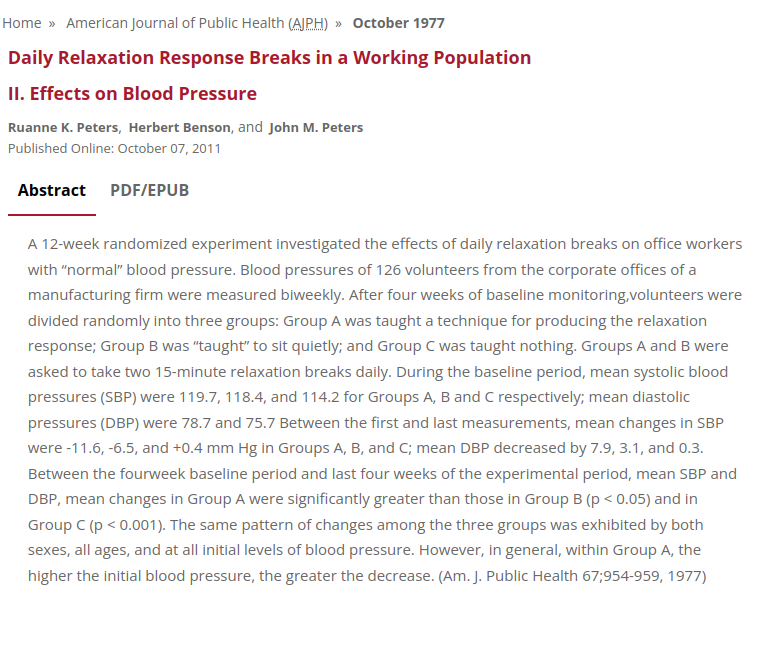A 12-week randomized experiment investigated the effects of daily relaxation breaks on office workers with “normal” blood pressure. Blood pressures of 126 volunteers from the corporate offices of a manufacturing firm were measured biweekly. After four weeks of baseline monitoring, volunteers were divided randomly into three groups: Group A was taught a technique for producing the relaxation response; Group B was “taught” to sit quietly; and Group C was taught nothing. Groups A and B were asked to take two 15-minute relaxation breaks daily. During the baseline period, mean systolic blood pressures (SBP) were 119.7, 118.4, and 114.2 for Groups A, B and C respectively; mean diastolic pressures (DBP) were 78.7 and 75.7 Between the first and last measurements, mean changes in SBP were -11.6, -6.5, and +0.4 mm Hg in Groups A, B, and C; mean DBP decreased by 7.9, 3.1, and 0.3. Between the fourweek baseline period and last four weeks of the experimental period, mean SBP and DBP, mean changes in Group A were significantly greater than those in Group B (p < 0.05) and in Group C (p < 0.001). The same pattern of changes among the three groups was exhibited by both sexes, all ages, and at all initial levels of blood pressure. However, in general, within Group A, the higher the initial blood pressure, the greater the decrease.
Daily Relaxation Response Breaks in a Working Population II. Effects on Blood Pressure
Publication
American Journal of Public Health
Abstract
Web and Email Links
Related Listings
Journal
Behavioral Medicine
To examine the extent to which advanced meditative practices might alter body metabolism and the electroencephalogram (EEG), we investigated three Tibetan Buddhist monks living in the Rumtek monastery in Sikkim, India. In a study carried out in February 1988, we found that during the practice of several different meditative practices, resting metabolism ([Vdot]O2) could be both raised (up to 61%) and lowered (down to 64%). The reduction from rest is the largest ever reported. On the […]
Journal
Yoga Alliance
About This Workshop 70-90% of all primary care visits in America are related to chronic stress and stress-related illnesses such as anxiety, depression, PTS, heart disease, headaches, GI disruptions, and more. In the next workshop of the Scientific Research series, Yoga Alliance Director of Research, Dr. Sat Bir Singh Khalsa is joined by Dr. John Denninger, Director of Research at the Benson-Henry Institute for Mind Body Medicine at Massachusetts General Hospital and Harvard Universit […]
Journal
Fertility and Sterility
Objective: To replicate previously reported psychological improvements in infertile women attending a group behavioral treatment program. Design: Psychological and demographic data were collected before entering and again upon completion of a behavioral medicine program on a second cohort of patients. Setting: The program was offered in the Division of Behavioral Medicine, an outpatient clinic of the Department of Medicine at New England Deaconess Hospital. All patients were receivi […]

